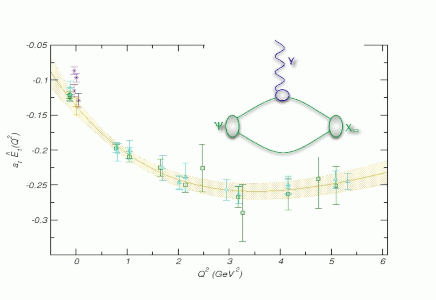Charmonium Spectrum and Quark Confinement

Electric dipole transition matrix element between χc0 and J/ψ charmonium systems as a function of photon virtuality Q2. Lattice data (green and blue) is fitted with a phenomenological form consistent with the quark model.The fitted curve agrees with experimental data (purple) at the real photon point Q2=0.
Enlarge
Additional Links
Hall D of the 12 GeV upgraded CEBAF will house the GlueX experiment, which intends to map the spectrum of mesons, the hybrid mesons in particular, through photoproduction off protons. Knowledge of the spectrum of hybrid mesons will aid us in understanding the nature of the confinement of quarks within hadrons, since within hybrids the gluonic field binding the meson is excited. Just as the excited states of hydrogen taught us about QED, we hope the excited states of glue in mesons will teach us about the non-trivial aspects of QCD.
An essential unknown in the GlueX proposal is the coupling strength of hybrid mesons to photons interacting with the meson cloud surrounding the proton target. Such quantities have been calculated within models such as the flux-tube model, in which the gluonic field between quarks forms itself into a tube, but no attempt has yet been made to make the computation directly from QCD. The first stage of a program to do this is underway in the Jefferson Lab Theory Center, where we are applying the powerful technique of lattice QCD to the problem.
Simulations within lattice QCD of hadrons made of realistically light quarks currently require either excessive computing time or a well-controlled theory with which to extrapolate data computed at un-physically heavy quark masses. Since neither of these are available for the problem at hand, the closely related problem of charmonium radiative transitions was addressed. Charmonia are mesons composed of a charm quark and an anti-charm quark, where the charm quark is a heavier cousin of the up quark, having the same color and electric charge, but a much larger mass. Charmonia are a subject of much interest at experimental facilities such as CLEO, BES, Belle, Babar and Fermilab, where despite thirty years of intense study, they continue to spring surprises. They provide a set of states analogous to the light mesons, but over which we have much tighter theoretical control, in lattice QCD and in models.
We have computed, for the first time within a lattice QCD simulation, the radiative transition rates between many of the lightest charmonium states, observing good agreement with experimental measurements. In addition, we are able to compute in regions inaccessible to experiment — and it is here that we have the power to test phenomenological models, which have the advantage of allowing computation "with paper and pencil" but the disadvantage of not being as closely related to the full theory of QCD.
References:
J. J. Dudek, R. G. Edwards and D. G. Richards, Phys. Rev. D73 (2006) 074507
F. E. Close and J. J. Dudek, Phys. Rev. Lett. 91 (2003) 142001

